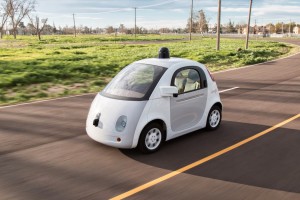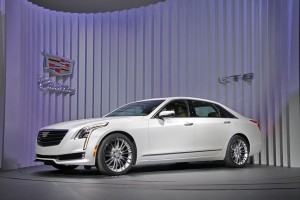
If sales of autonomous vehicles, like Google's, take off, it could have a significant impact on new vehicle sales.
Sometime next year, General Motors will introduce the SuperDrive system on the new Cadillac CT6 sedan. Capable of hands-free freeway motoring, it will help usher in an era of autonomous driving that proponents – including GM – believe will revolutionize the transportation industry.
But a new study warns that not all the changes to come will be good for GM and other automakers. Titled “Disruptive Mobility,” and produced by Brian Johnson, a Barclays automotive analyst, it warns that self-driving vehicles could lead to a sharp drop in U.S. car sales in the years ahead.
Over the next 25 years, as autonomous vehicles become the norm, rather than the exception, the study predicts U.S. car sales will drop from nearly 17 million this year to perhaps 9.5 million. That’s even lower than what the industry experienced during the depths of the Great Recession.
Eventually, there could be as few as 100 million vehicles on American roads, Johnson forecasts, down from 250 million today.

The Cadillac CT6 - as big as a BMW 7-, as light as a 5-Series...and will drive itself in 2017. However, will it mean a drop in new car sales?
“While extreme, a historical precedent exists,” writes Johnson. “Horses once filled the many roles that cars fill today, but as the automobile came along, the population of horses dropped sharply.”
One reason for the sharp drop in sales, Johnson anticipates, is that American households will be less likely to own and operate a fleet of vehicles. Instead, autonomous vehicles will be shared by various family members.
Meanwhile, there will be other, more affordable options, emerging that might convince more Americans to abandon vehicle ownership. That includes car-sharing services, such as Uber and Lyft. Some motorists have already begun to turn to those services as cost-effective alternatives. And the appeal might grow even greater if such ride-sharing ventures can field driverless vehicles to cut their own costs – a goal expressly targeted by the CEO of Uber.
“By removing the driver from the equation, the average cost per mile to the consumer could be 44 cents for a private ride in a standard sedan and 8 cents for a shared ride in a two-seater,” calculated Johnson, becoming far cheaper than operating a privately owned vehicle.
(Nissan will build autonomous vehicles by 2020. For more, Click Here.)
Once autonomous vehicles become commonplace, Johnson foresees four categories of automobiles:
- Privately owned cars and trucks driven by individuals to work in rural areas;
- Family autonomous vehicles shared by an entire family;
- Shared autonomous vehicles that might be summoned by a smartphone app, much like the current Uber and Lyft system operates; and
- Pooled autonomous vehicles that would be shared among multiple riders, much like a bus.
GM and other automakers have begun to acknowledge that the century-old model of personal vehicle ownership is in transition. Ford Motor Co. CEO Mark Fields earlier this year outlined the automaker’s ongoing efforts to create a new “mobility” strategy. Ford has been actively partnering, for example, with car-sharing services that provide vehicles for short-term rental.
But the makers continue to hope that the pessimistic outlook painted by the Disruptive Mobility study won’t come to pass.
(Click Here for details about Google’s plans for testing its cars in cities.)
A separate study, titled “Emerging Technologies: Autonomous Cars — Not If, But When,” predicted that by 2035, self-driving cars, or SDCs, will account for half the vehicles sold in North America. Worldwide sales will reach about 11.8 million, according to IHS Automotive, which prepared the report released last January. By 2050, the consulting firm estimated, almost all vehicles will offer an autonomous mode.
Separate research by the University of Michigan Transportation Research Institute found that the vast majority of American households owning three vehicles or more actually could get by with fewer cars, trucks and crossovers. It reported that in only 2% of those homes were there overlapping trips that would routinely require at least three vehicles.
(To see more about feds plans to rush out connected car rules, Click Here.)
If the cost of alternative transportation were to drop enough, that would suggest many such households might trim back the number of vehicles in their garages.

Call me a naysayer. Call me a Luddite. Call me retro. Call me wrong. But I don’t think self driving cars are going to catch on in the U.S. I do think they’re the current fad amongst some “technologists” who either aren’t too grounded in reality or realize that there’s a paycheck to be had by me-tooing the predictions about how everyone is going to leave the driving to Rosie the Robot. I read an article somewhere whose title was something like “What will you do when all new cars are self driving?”. The comment that best captured what readers who responded had to say was something like “Find a used car that wants to be driven.”
I’m sorry but their study conclusions of lower sales makes zero sense. If we aren’t sharing a vehicle now, why would would we suddenly share a vehicle when the only difference is that we just sit there with our hands off the wheel? Opposite destinations now means two vehicles, opposite destinations after autonomous means two vehicles. Now I could see an increase in vehicle sales instead if non-drivers are allowed to ‘operate’ an autonomous. High school kids with lots of activities could have their own car take them around town even before they had a license.
The study really misses the obvious. The horse was widespread transportation but the car offered better capabilities and car sales exploded. A modern comparison is where conventional cell phones were widely used but then smart phones offered better capabilities and what happened? Sales increase. So if autonomous vehicles offer more, then car sales will increase, otherwise sales will stay about the same, i.e. tracking the general economy.
I hope no one actually paid for this report. What a clueless conclusion. Where do people come up with this insanity? According to some so called “experts” we were suppose to have paperless offices 20 years ago. We are also suppose to be post PC right now yet millions of PCs are being sold every year. We were suppose to driving flying cars 25 years ago yet only a few are even being attempted today.
I’d be surprised if true AVs, not cruise control style “AVs” represent more than 10% of the new car market – ever.
Quite a prediction but we are not talking about migrating from Windows 7 to Windows 8. They still have a problem making sure basis programming works dependably. I am sure that those that live life at 25mph can’t wait to shirk the responsibility of paying attention while driving. As they used to say, driving is a privilege, not a right. I enjoy the privilege of driving myself secure that I will not be killed by software any time soon.
Do people get paid to plant this foolishness in the media?
Concluding that most people will switch to AVs is an absurd conclusion, IMO. I do see those in need switching to an AV to maintain personal freedom to travel when and where they desire. I don’t see the majority of people converting to AVs however.
Before we get the cart before the horse there is a lot of work that must be done just to get AVs to the point of being a viable form of transportation which is 100% reliable with redundant systems and proper “limp mode” programming for when the systems do fail or get confused or are hacked or what ever.
That is a very significant hurdle to overcome. Until that happens AVs should not be allowed on the roadways without a driver in place to take control of the vehicle.